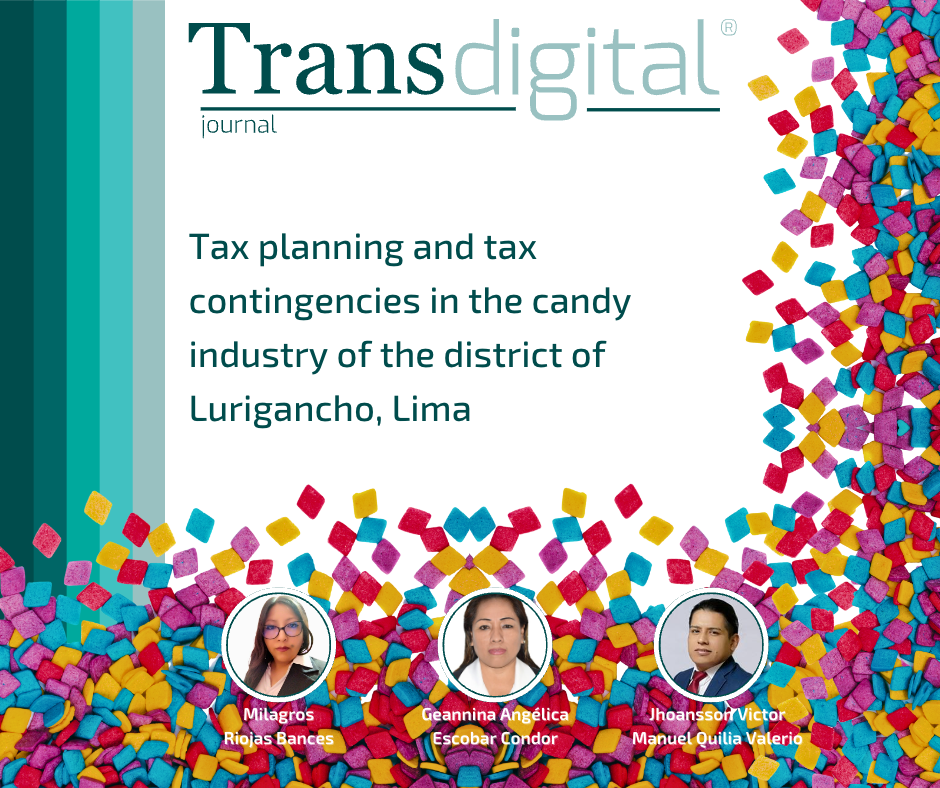Tax planning and tax contingencies in the candy industry of the district of Lurigancho, Lima
DOI:
https://doi.org/10.56162/transdigital247Keywords:
tax obligations, tax contingencies, fines, sanctions, tax burdenAbstract
The aim of the research was to determine the existing relationship between planning and tax contingencies in the candy industry of the district of Lurigancho, Lima, 2022. The method was of a quantitative approach, applied type, non-experimental design-cross section, level correlational. A questionnaire was designed which was validated by expert judgment; It was applied through the survey technique. The sample consisted of 40 professionals from the accounting area, administrative area, and treasury area of ??four companies in the candy industry, which was determined through an intentional non-probabilistic sampling. To test the hypotheses, Spearman's Rho was used to measure the correlation of the variables. The results revealed that, through the non-parametric Rho Spearman test, a sig. bilateral of 0.000 and a correlation coefficient of .797, which allowed us to accept that tax planning is significantly related to tax contingencies. This relationship is highly positive, according to the data analyzed. It was concluded that tax planning seeks to optimize the tax burden of companies, while tax contingencies are the risks or problems that may arise in relation to tax obligations. Both aspects are important in business practice to guarantee efficient tax management and comply with legal obligations, according to regulations.
References
Aguirre, B., Jaramillo, N., & Solano, M. (2019). Contingencias Tributarias y su incidencia en la determinación del impuesto a la renta del periodo 2016 al 2018 de la Librería Ofischool EIRL. Chimbote 2019. Revista Científica Horizonte Empresarial, 6(2). 35-51. https://revistas.uss.edu.pe/index.php/EMP/article/view/1190
Baena Paz, G. (2017). Metodología de la investigación. Grupo Editorial Patria. http://www.biblioteca.cij.gob.mx/Archivos/Materiales_de_consulta/Drogas_de_Abuso/Articulos/metodologia%20de%20la%20investigacion.pdf
Caamal Yam, E., Cortes Pérez, I. D., & Solís Vargas, K. G. (2019). La planeación fiscal como estrategia para la toma de decisiones. Tlatemoani, 10(30), 188-206. https://www.eumed.net/rev/tlatemoani/30/planeacion-fiscal.html
Effio, G. & Chapoñan Ramírez, E. (2019). Planeamiento tributario para evitar contingencias tributarias en la empresa Vimalca EIRL Chiclayo, 2018. Revista Científica Horizonte Empresarial, 6(2), 20-21-22. https://revistas.uss.edu.pe/index.php/EMP/article/view/1189
Encalada-Benítez, D. L., Narváez-Zurita, C. I., & Erazo Álvarez, J. C. (2020). La planificación tributaria, una herramienta útil para la toma de decisiones en las comercializadoras de GLP. Revista Científica Dominio de las Ciencias. 6(1). 99-126. https://dominiodelasciencias.com/ojs/index.php/es/article/view/1138
García Centeno, D. S., Narváez Zurita, I. C., Giler Escandón, L. V., & Erazo Álvarez, J. C. (2019). Planificación tributaria como herramienta mitigadora de riesgos fiscales en la industria camaronera. Visionario Digital, 3(2.1.), 550-576. https://doi.org/10.33262/visionariodigital.v3i2.1.588
Goranka, K., & Pavlovic, V. (2023). Accounting and Non-accounting Concepts of Effective Tax Rates and their Effects on Tax Planning in State-owned Companies. Lex Localis, 21(2). https://doi.org/10.4335/21.2.323-341(2023)
Hernández-Sampieri, R., & Mendoza Torres, C. P. (2018). Metodología de la investigación: las rutas cuantitativa, cualitativa y mixta. Mc Graw Hill Educación. http://repositoriobibliotecas.uv.cl/handle/uvscl/1385
Kim, J., McGuire, S., Savoy, S., & Wilson, R. (2022). Expected economic growth and investment in corporate tax planning. Review of Accounting Studies, 27. 745–778. https://doi.org/10.1007/s11142-021-09625-5
Mendoza, J. (2020). Sistema de planificación de proyectos en el desarrollo de nuevos productos en empresas de alimentos dedicadas al rubro de golosinas. Ciencia Latina Revista Científica Multidisciplinar, 5(5), 10132-10154. https://doi.org/10.37811/cl_rcm.v5i5.1058
Tuesta Bardalez, S. E., & Espinoza Poves, J. L. (2019). El impacto de las obligaciones tributarias electrónicas en la formalización de las micro y pequeñas empresas peruanas. TZHOECOEN, 11(4), 51–62. https://doi.org/10.26495/tzh.v11i4.1234
Vega-Quispe, L., Seminario-Unzueta, R., & Romero-Coronado, W. (2020). Planeamiento tributario en el área contable de la empresa epresentaciones Naret S.A.C. - La Molina, 2019. Ágora, 7(1). 38-43. https://doi.org/10.21679/arc.v7i1.145
Villasmil, M. (2017). La planificación tributaria: Herramienta legítima del contribuyente en la gestión empresarial. Dictamen Libre.121-128. https://bit.ly/2ZtMxHx
Yanarico Pacompia, M., Calsin Ramos, S., Calizaya Ruelas, Y. P., & Mamani Monrroy, K. Y. (2021). Planeamiento tributario y determinación del impuesto a la renta en las empresas textiles de la ciudad de Arequipa caso artexsurle E.I.R.L., periodo 2020. Ciencia Latina Revista Multidisciplinar, 5(6). https://doi.org/10.37811/cl_rcm.v5i6.1199

Downloads
Autor de correspondencia
El autor de correspodencia se identifica con el siguiente símbolo: *Published
How to Cite
License
Copyright (c) 2023 Milagros Riojas Bances, Geannina Angélica Escobar Condor; Jhoansson Victor Manuel Quilia Valerio

This work is licensed under a Creative Commons Attribution 4.0 International License.
All articles in Transdigital are licensed under a Creative Commons Attribution 4.0 International License. Authors hold the copyright and retain publishing rights without restrictions.









